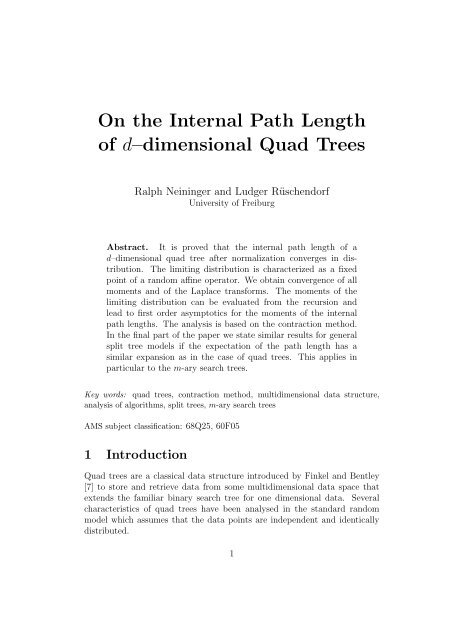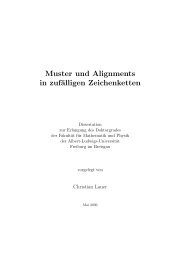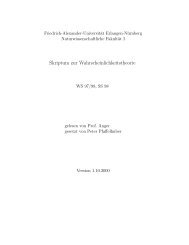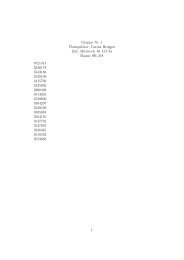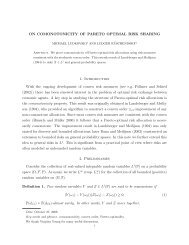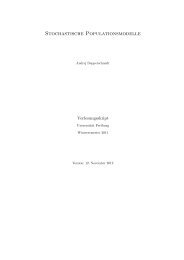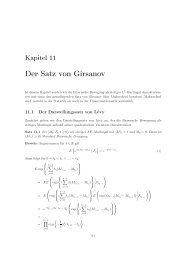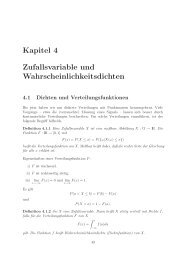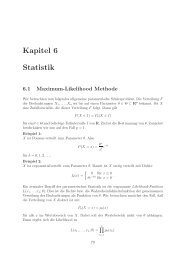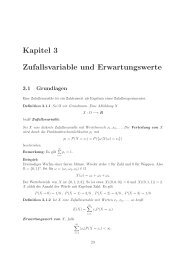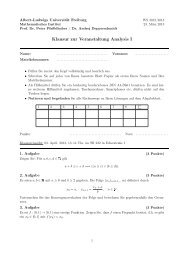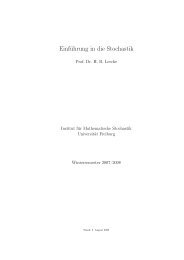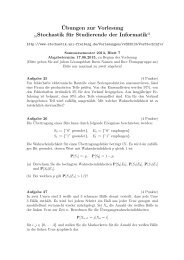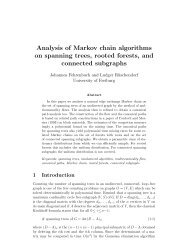On the Internal Path Length of dâdimensional Quad Trees
On the Internal Path Length of dâdimensional Quad Trees
On the Internal Path Length of dâdimensional Quad Trees
Create successful ePaper yourself
Turn your PDF publications into a flip-book with our unique Google optimized e-Paper software.
<strong>On</strong> <strong>the</strong> <strong>Internal</strong> <strong>Path</strong> <strong>Length</strong><br />
<strong>of</strong> d–dimensional <strong>Quad</strong> <strong>Trees</strong><br />
Ralph Neininger and Ludger Rüschendorf<br />
University <strong>of</strong> Freiburg<br />
Abstract. It is proved that <strong>the</strong> internal path length <strong>of</strong> a<br />
d–dimensional quad tree after normalization converges in distribution.<br />
The limiting distribution is characterized as a fixed<br />
point <strong>of</strong> a random affine operator. We obtain convergence <strong>of</strong> all<br />
moments and <strong>of</strong> <strong>the</strong> Laplace transforms. The moments <strong>of</strong> <strong>the</strong><br />
limiting distribution can be evaluated from <strong>the</strong> recursion and<br />
lead to first order asymptotics for <strong>the</strong> moments <strong>of</strong> <strong>the</strong> internal<br />
path lengths. The analysis is based on <strong>the</strong> contraction method.<br />
In <strong>the</strong> final part <strong>of</strong> <strong>the</strong> paper we state similar results for general<br />
split tree models if <strong>the</strong> expectation <strong>of</strong> <strong>the</strong> path length has a<br />
similar expansion as in <strong>the</strong> case <strong>of</strong> quad trees. This applies in<br />
particular to <strong>the</strong> m-ary search trees.<br />
Key words: quad trees, contraction method, multidimensional data structure,<br />
analysis <strong>of</strong> algorithms, split trees, m-ary search trees<br />
AMS subject classification: 68Q25, 60F05<br />
1 Introduction<br />
<strong>Quad</strong> trees are a classical data structure introduced by Finkel and Bentley<br />
[7] to store and retrieve data from some multidimensional data space that<br />
extends <strong>the</strong> familiar binary search tree for one dimensional data. Several<br />
characteristics <strong>of</strong> quad trees have been analysed in <strong>the</strong> standard random<br />
model which assumes that <strong>the</strong> data points are independent and identically<br />
distributed.<br />
1
The mean depth has been found in Flajolet, Labelle, Laforest and Salvy<br />
[9];<br />
IED n = λ d ln n + µ d + o(1) (1)<br />
with λ d = 2/d and µ d has an explicit (more complicated) form which is e.g.<br />
for d = 2 given by 0.4105 . . . numerically. The first order asymptotic had<br />
been given before independently by Flajolet, Gonnet, Puech and Robson [8]<br />
and Devroye and Laforest [5]. The variance <strong>of</strong> D n is <strong>of</strong> order (2/d 2 ) ln n<br />
(see Devroye and Laforest [5] for d = 2 and Flajolet and Lafforgue [10] for<br />
d ≥ 2). In <strong>the</strong> last mentioned paper also asymptotic normality <strong>of</strong> D n has<br />
been proved.<br />
The expected height H n still is <strong>of</strong> logarithmic order (see Devroye [2], [3])<br />
IEH n ∼ c ln n, c = 4.31107 . . . (2)<br />
d<br />
and H n / ln n → P c/d (where → P denotes convergence in probability). The<br />
asymptotic variance and distribution are still unknown. For a presentation<br />
<strong>of</strong> basic results and an introduction to alternative data structures we refer<br />
to Mahmoud [12].<br />
In this paper we investigate <strong>the</strong> asymptotics <strong>of</strong> <strong>the</strong> internal path length<br />
Y n , i.e. <strong>of</strong> <strong>the</strong> sum <strong>of</strong> <strong>the</strong> levels <strong>of</strong> each node <strong>of</strong> <strong>the</strong> quad tree built from n<br />
random data. The asymptotics <strong>of</strong> <strong>the</strong> mean IEY n results from (1)<br />
IEY n = 2 d n ln n + µ dn + R n (3)<br />
where lim R n /n = 0.<br />
We will prove that <strong>the</strong> variance <strong>of</strong> Y n is asymptotically <strong>of</strong> <strong>the</strong> form ∼ v d n 2<br />
and obtain an explicit formula for v d . We, <strong>the</strong>refore, introduce <strong>the</strong> normalized<br />
internal path length<br />
X n = Y n − IEY n<br />
. (4)<br />
n<br />
Our main result in this paper states that X n converges weakly to a random<br />
variable X which is characterized as <strong>the</strong> fixed point <strong>of</strong> a random affine operator<br />
T . We also obtain convergence <strong>of</strong> all moments and <strong>of</strong> <strong>the</strong> Laplace<br />
2
transform; X has exponential tails. It’s moments are determined (in principle)<br />
by a recursion. We calculate <strong>the</strong> second moment <strong>of</strong> X which gives <strong>the</strong><br />
asymptotic variance v d <strong>of</strong> Y n .<br />
For <strong>the</strong> pro<strong>of</strong> we extend <strong>the</strong> contraction method introduced by Rösler [16]<br />
for <strong>the</strong> analysis <strong>of</strong> Quicksort to <strong>the</strong> analysis <strong>of</strong> <strong>the</strong> internal path length <strong>of</strong> quad<br />
trees. It seems difficult to extend <strong>the</strong> martingale method which was used in<br />
Régnier [15] for <strong>the</strong> analysis <strong>of</strong> Quicksort. The contraction method has been<br />
fur<strong>the</strong>r developed independently in Rösler [17] and Rachev and Rüschendorf<br />
[14]. The essential ingredient our pro<strong>of</strong> uses is <strong>the</strong> recursion satisfied by Y n<br />
plus <strong>the</strong> second order asymptotics <strong>of</strong> <strong>the</strong> first moments as in (3). We do<br />
not need a priori asymptotics <strong>of</strong> <strong>the</strong> second moments. The explanation <strong>of</strong><br />
this behavior from <strong>the</strong> point <strong>of</strong> view <strong>of</strong> <strong>the</strong> contraction method is <strong>the</strong> fact,<br />
that <strong>the</strong> limiting operator T <strong>of</strong> <strong>the</strong> recursion <strong>of</strong> <strong>the</strong> Y n (which exists by <strong>the</strong><br />
asymptotics <strong>of</strong> IEY n !) has contraction properties w.r.t. <strong>the</strong> l 2 –metric. This<br />
implies that only control <strong>of</strong> <strong>the</strong> first moments is necessary as is well known<br />
from <strong>the</strong> <strong>the</strong>ory <strong>of</strong> probability metrics.<br />
In <strong>the</strong> final part <strong>of</strong> <strong>the</strong> paper we consider general split tree models as<br />
introduced in Devroye [4]. The limit <strong>the</strong>orem for <strong>the</strong> quad trees extends to<br />
this class <strong>of</strong> split trees if <strong>the</strong> first moment <strong>of</strong> <strong>the</strong> path length has a similar<br />
expansion <strong>of</strong> <strong>the</strong> form cn ln n + dn + o(n), as in <strong>the</strong> case <strong>of</strong> quad trees. This<br />
method thus yields a limit <strong>the</strong>orem also for m-ary trees.<br />
The authors would like to thank P. Flajolet for an essential hint to <strong>the</strong><br />
limiting distribution.<br />
2 <strong>Quad</strong> trees and <strong>the</strong> internal path length<br />
A quad tree is constructed similarly to a binary search tree. Given a data<br />
vector (p (1) , . . . , p (n) ), p (i) ∈ IR d , <strong>the</strong> points p (i) build up successively <strong>the</strong><br />
quad tree. Without loss <strong>of</strong> generality p (i) ∈ [0, 1] d . Then <strong>the</strong> i–th data<br />
point p (i) ∈ [0, 1] d partitions <strong>the</strong> rectangle it belongs to into 2 d quadrants<br />
and thus creates 2 d new rectangles (quadrants) each having p (i) as a vertex.<br />
See Flajolet, Gonnet, Puech and Robson [8] or Mahmoud [12] for details <strong>of</strong><br />
this contruction. We use a special ordering for <strong>the</strong> insertion <strong>of</strong> a new key<br />
p ∈ [0, 1] d as in Flajolet et al. [8]. When comparing p with a node w ∈ [0, 1] d<br />
<strong>of</strong> <strong>the</strong> quad tree we determine <strong>the</strong> number <strong>of</strong> <strong>the</strong> subtree in which p is inserted<br />
in <strong>the</strong> following way: The node w partitions <strong>the</strong> quadrant it belongs to into<br />
3
2 d subquadrants. Let <strong>the</strong> number <strong>of</strong> a subquadrant be given by<br />
d∑<br />
2 k−1 1 {wk ≤s k }, w = (w i ), s = (s i ) (5)<br />
k=1<br />
if s is a point in this subquadrant. Now, p is inserted in <strong>the</strong> i–th subtree if<br />
it belongs to <strong>the</strong> i–th subquadrant. For <strong>the</strong> binary representation <strong>of</strong> 0 ≤ i ≤<br />
2 d − 1<br />
let<br />
d∑<br />
i = a k 2 k−1 , a k = a k (i) ∈ {0, 1} (6)<br />
k=1<br />
E(i) := {k ∈ {1 . . . , d} | a k (i) = 1},<br />
N(i) := {k ∈ {1 . . . , d} | a k (i) = 0}.<br />
Then equivalently, p is inserted in <strong>the</strong> i–th subtree <strong>of</strong> a node w if p k ≥ w k<br />
for all k ∈ E(i) and p k < w k for all k ∈ N(i).<br />
A random d–dimensional quad tree is a quad tree built up by inserting<br />
a sequence <strong>of</strong> points (p (1) , . . . , p (n) ) independent and identically distributed<br />
on [0, 1] d . Note that <strong>the</strong> insertion depends only on <strong>the</strong> relative ranks <strong>of</strong> <strong>the</strong><br />
components and so <strong>the</strong> results for random quad trees hold true for general<br />
multivariate distributions with continuous marginals and independent components.<br />
For a random quad tree with n nodes let I (n) = (I (n)<br />
0 , . . . , I (n)<br />
2 d −1 ) denote<br />
<strong>the</strong> number <strong>of</strong> nodes in <strong>the</strong> 2 d subtrees. Let U = (U 1 , . . . , U d ) denote <strong>the</strong> first<br />
key to be inserted, i.e. U 1 , . . . , U d are independent, uniformly distributed on<br />
[0, 1]. Given U = u = (u 1 , . . . , u d ), <strong>the</strong> volume <strong>of</strong> <strong>the</strong> i–th quadrant (in <strong>the</strong><br />
above numbering) generated by U is given by<br />
〈u〉 i :=<br />
∏ ∏<br />
(1 − u k ) (i = 0, . . . , 2 d − 1). (7)<br />
u k<br />
k∈N(i) k∈E(i)<br />
Let 〈u〉 := (〈u〉 0 , . . . , 〈u〉 2 d −1) denote <strong>the</strong> vector <strong>of</strong> <strong>the</strong> generated volumes,<br />
<strong>the</strong>n I (n) is conditionally given U = u multinomial M(n−1, 〈u〉) distributed:<br />
IP I(n) | U=u = M(n − 1, 〈u〉). (8)<br />
In <strong>the</strong> following we denote convergence in probability and convergence in<br />
distribution by P → and D → respectively and write D = for equality in distribution<br />
4
when ei<strong>the</strong>r two random variables are compared or a random variable and a<br />
probability distribution are compared.<br />
The conditional distribution in (8) implies <strong>the</strong> week law <strong>of</strong> large numbers<br />
for I (n) .<br />
Lemma 2.1 The vector I (n) <strong>of</strong> <strong>the</strong> sizes <strong>of</strong> <strong>the</strong> subtrees satisfies<br />
IE<br />
( I<br />
(n)<br />
k<br />
n<br />
− 〈U〉 k<br />
) 2<br />
= IE〈U〉 k(1 − 〈U〉 k )<br />
n<br />
(9)<br />
and<br />
I (n)<br />
n<br />
where U is uniformly distributed on [0, 1] d .<br />
P<br />
−→ 〈U〉 = (〈U〉 0 , . . . , 〈U〉 2 d −1) (10)<br />
From a geometrical point <strong>of</strong> view Lemma 2.1 says that <strong>the</strong> limiting distribution<br />
<strong>of</strong> I (n) /n is concentrated on a d–dimensional smooth surface embedded<br />
in a (2 d −1)–dimensional simplex in IR 2d . In particular, for d = 2 this surface<br />
is a hyperbolic paraboloid.<br />
Since 0 ≤ ‖I (n) /n‖ ≤ 1, Lemma 2.1 implies <strong>the</strong> convergence <strong>of</strong> all moments.<br />
We shall need second moments in <strong>the</strong> following.<br />
Corollary 2.2 The asymptotic <strong>of</strong> <strong>the</strong> second moments <strong>of</strong> I (n) /n is given by<br />
⎛<br />
lim IE n→∞<br />
⎞2<br />
⎝ I(n) k ⎠<br />
n<br />
= (1/3) d . (11)<br />
Pro<strong>of</strong>:<br />
⎛<br />
lim IE n→∞<br />
⎞2<br />
⎝ I(n) k ⎠<br />
n<br />
= IE〈U〉 2 k = IE〈U〉 2 0 = IE(U 1 · . . . · U d ) 2<br />
= (IEU 2 1 ) d = (1/3) d<br />
since 〈U〉 k D = 〈U〉 0 and <strong>the</strong> components are independent.<br />
Let Y n denote <strong>the</strong> internal path length <strong>of</strong> <strong>the</strong> random d–dimensional quad<br />
tree, i.e. Y n is <strong>the</strong> sum <strong>of</strong> <strong>the</strong> depths <strong>of</strong> <strong>the</strong> nodes in <strong>the</strong> quad tree where<br />
5
<strong>the</strong> depth <strong>of</strong> <strong>the</strong> root is defined to be one; <strong>the</strong>n Y 1 = 1, Y 2 = 3, . . . Since <strong>the</strong><br />
subtrees <strong>of</strong> a random quad tree are again random quad trees <strong>the</strong> following<br />
recursion for <strong>the</strong> internal path length holds in distribution<br />
Y n D =<br />
2 d −1 ∑<br />
k=0<br />
Y (k) + n (12)<br />
I (n)<br />
k<br />
where (Y (k)<br />
i ) are independent copies <strong>of</strong> Y i and {(Y (k)<br />
i ), k = 0, . . . , 2 d −1}, I (n)<br />
are independent. We define Y 0 := 0. The expectation <strong>of</strong> <strong>the</strong> internal path<br />
length Y n is given in (3). The normalized version X n <strong>of</strong> Y n given by<br />
satisfies <strong>the</strong> modified recursion<br />
X n := Y n − IEY n<br />
n<br />
(13)<br />
X n D =<br />
2 d −1 ∑<br />
k=0<br />
I (n)<br />
k<br />
n X(k) I (n)<br />
k<br />
+ C n (I (n) ) (14)<br />
where (X (k)<br />
i ) are independent copies <strong>of</strong> X i , fur<strong>the</strong>r {(X (k)<br />
i ), k = 0, . . . , 2 d −<br />
1}, I (n) are independent and<br />
⎛<br />
⎞<br />
C n (i) := 1 + 1 2∑<br />
d −1<br />
⎝ IEY ik − IEY n<br />
⎠ (15)<br />
n<br />
k=0<br />
for i = (i 0 , . . . , i 2 d −1) with ∑ i k = n − 1.<br />
3 Limit <strong>the</strong>orem for <strong>the</strong> internal path length<br />
In order to obtain a limiting form <strong>of</strong> <strong>the</strong> recursion (14) we introduce <strong>the</strong><br />
simplex<br />
and <strong>the</strong> entropy functional<br />
T 2 d −1 := {x ∈ [0, 1] 2d |<br />
2 d −1 ∑<br />
i=0<br />
C : T 2 d −1 → IR, C(x) := 1 + 2 d<br />
6<br />
x i = 1} (16)<br />
2 d −1 ∑<br />
i=0<br />
x i ln x i (17)
where x ln x is defined to be 0 for x = 0. Let<br />
G n := {(i 0 , . . . , i 2 d −1) ∈ IN 2d |<br />
2 d −1 ∑<br />
k=0<br />
i k = n − 1}<br />
denote <strong>the</strong> domain <strong>of</strong> C n , <strong>the</strong>n as in Rösler [16] C approximates C n in <strong>the</strong><br />
following sense:<br />
Lemma 3.1 Let (z (n) ) be a sequence, z (n) ∈ G n such that z (n) /n → z ∈<br />
(0, 1] 2d , <strong>the</strong>n<br />
Fur<strong>the</strong>rmore<br />
lim C n(z (n) ) = C(z). (18)<br />
n→∞<br />
sup ‖C n ‖ ∞ < ∞. (19)<br />
n∈IN<br />
Pro<strong>of</strong>: Let (z (n) ) be a sequence, (z (n) ) ∈ G n such that z (n) /n → z ∈ (0, 1] 2d .<br />
Using <strong>the</strong> expansion (3) <strong>of</strong> <strong>the</strong> expectation <strong>of</strong> Y n ,<br />
we obtain<br />
⎛<br />
C n (z (n) ) = 1+ 1 ∑<br />
⎝<br />
n<br />
IEY n = 2 d n ln n + µ dn + R n with R n /n = o(1),<br />
= 1+ 1 n<br />
2 d −1<br />
k=0<br />
⎛<br />
2∑<br />
d −1<br />
⎝<br />
k=0<br />
IEY z<br />
(n)<br />
k<br />
( 2<br />
d z(n) k<br />
− IEY n<br />
⎞<br />
⎠ (20)<br />
ln z (n)<br />
k<br />
Since ∑ 2 d −1<br />
k=0 z(n) k = n − 1 by definition <strong>of</strong> G n ,<br />
2 d −1 ∑<br />
k=0<br />
2<br />
d z(n) k<br />
ln z (n)<br />
k<br />
With (20) and (21) we derive<br />
⎛ ⎛<br />
C n (z (n) ) = 1 + 1 2∑<br />
d −1<br />
⎝<br />
n<br />
− 2 2 d −1<br />
d n ln n = ∑<br />
k=0<br />
= C(z (n) /n) + 1 n<br />
⎝ 2 d z(n) k<br />
2 d −1 ∑<br />
k=0<br />
+ µ dz (n) + R z (n)<br />
k=0<br />
ln z(n) k<br />
n<br />
R z<br />
(n)<br />
k<br />
7<br />
2<br />
k<br />
d z(n) k<br />
− 1 n<br />
+ R z (n)<br />
k<br />
k<br />
)<br />
− 2 d n ln n−µ dn −R n<br />
⎞<br />
⎠.<br />
ln z(n) k<br />
n − 2 ln n. (21)<br />
d<br />
⎞<br />
⎞<br />
⎠ − 2 d ln n − µ d − R n<br />
⎠<br />
( 2<br />
d ln n − µ d − R n<br />
)<br />
. (22)
Now observe that<br />
2α :=<br />
min z k > 0<br />
0≤k≤2 d −1<br />
since z ∈ (0, 1] 2d . This implies z (n)<br />
k ≥ αn for 0 ≤ k ≤ 2 d −1 and n sufficiently<br />
large. Let ¯R n := sup i≥n |R i |. Then ( ¯R n ) n∈IN is decreasing and ¯R n /n → 0.<br />
For n sufficiently large it follows<br />
2<br />
1 ∑<br />
d −1<br />
R (n)<br />
∣n<br />
z k<br />
k=0 ∣<br />
≤<br />
≤<br />
1 n<br />
1 n<br />
2 d −1 ∑<br />
k=0<br />
2 d −1 ∑<br />
k=0<br />
¯R z<br />
(n)<br />
k<br />
¯R ⌊αn⌋<br />
≤ 2 d α 1<br />
⌊αn⌋ ¯R ⌊αn⌋ → 0 for n → ∞. (23)<br />
The third summand <strong>of</strong> (22) also tends to zero. So (22) implies<br />
C n (z (n) ) = C(z (n) /n) + o(1).<br />
Therefore, continuity <strong>of</strong> C and <strong>the</strong> triangle inequality imply<br />
∣<br />
∣C n (z (n) ) − C(z) ∣ ∣ ∣ ≤ ∣∣Cn<br />
(z (n) ) − C(z (n) /n) ∣ ∣ ∣ + ∣∣C(z (n) /n) − C(z) ∣ ∣ −→ 0.<br />
In order to get an estimate for C n (z (n) ) uniformly in z (n) ∈ G n let<br />
Then (22) implies<br />
The second claim follows.<br />
L := sup |R n /n| < ∞.<br />
n∈IN<br />
|C n (z (n) )| ≤ |C(z (n) /n)| + 2 d L + o(1)<br />
≤ ‖C‖ ∞ + 2 d L + o(1). (24)<br />
Lemmas 2.1, 3.1 suggest that a limit X <strong>of</strong> (X n ) is a solution <strong>of</strong> <strong>the</strong> limiting<br />
equation<br />
X D =<br />
2∑<br />
d −1<br />
k=0<br />
〈U〉 k X (k) + C(〈U〉) (25)<br />
8
where X (k) are iid copies <strong>of</strong> X and {X (k) , k = 0, . . . 2 d −1}, U are independent,<br />
U uniformly distributed on [0, 1] d .<br />
Define<br />
M 0,2 := { µ ∈ M 1 (IR 1 , B 1 ) | IEµ = 0, Var µ < ∞} (26)<br />
where IEµ, Var µ are defined as expectation respectively variance <strong>of</strong> a corresponding<br />
random variable and M 1 (IR 1 , B 1 ) denotes <strong>the</strong> space <strong>of</strong> probability<br />
measures on <strong>the</strong> real line. Define <strong>the</strong> random affine operator<br />
T : M 1 (IR 1 , B 1 ) → M 1 (IR 1 , B 1 ), T (µ) D =<br />
2∑<br />
d −1<br />
k=0<br />
〈U〉 k Z (k) + C(〈U〉) (27)<br />
where (Z (k) ), U are independent, Z (k) D = µ and U is uniformly distributed on<br />
[0, 1] d .<br />
Our aim is to show that T is <strong>the</strong> limiting operator <strong>of</strong> <strong>the</strong> recursive sequence<br />
(X n ) in (14). Supply M 0,2 ⊂ M 1 (IR 1 , B 1 ) with <strong>the</strong> minimal l 2 –metric<br />
l 2 (µ, ν) = inf{(IE|X − Y | 2 ) 1/2 : X D = µ, Y D = ν}. (28)<br />
For random variables X, Y we use synonymously l 2 (X, Y ) = l 2 (IP X , IP Y ).<br />
Then (M 0,2 , l 2 ) is a complete metric space and l 2 (µ n , µ) → 0 is equivalent to<br />
∫<br />
∫<br />
µ D n → µ and x 2 dµ n (x) → x 2 dµ(x). (29)<br />
(see Rachev [13])<br />
Lemma 3.2 T : M 0,2 → M 0,2 is a contraction w.r.t. l 2 :<br />
( ) 2 d/2<br />
l 2 (T (µ), T (ν)) ≤ l 2 (µ, ν) for all µ, ν ∈ M 0,2 . (30)<br />
3<br />
Pro<strong>of</strong>:<br />
Obviously Var (T (µ)) < ∞ and<br />
IET (µ) = 1 + 2 d<br />
2 d −1 ∑<br />
k=0<br />
IE [〈U〉 k ln〈U〉 k ]<br />
= 1 + 2 d 2d IE [〈U〉 0 ln〈U〉 0 ]<br />
= 1 + 2 d 2d ∫[0,1] d u 1 · · · u d ln(u 1 · · · u d ) dλ d (u)<br />
9
= 1 + 2 d+1 (∫ 1<br />
0<br />
) d−1 ∫ 1<br />
u du u ln u du<br />
0<br />
= 1 + 4(−1/4) = 0 (31)<br />
so T is a well defined mapping T : M 0,2 → M 0,2 .<br />
To prove contractivity let µ, ν ∈ M 0,2 and let (V (k) , W (k) ), U be independent,<br />
U uniformly distributed on [0, 1] d . Let (V (k) , W (k) ) be optimal l 2 –<br />
couplings <strong>of</strong> (µ, ν), i.e. V (k) D = µ, W (k) D = ν and l 2 2(µ, ν) = IE(V (k) − W (k) ) 2 .<br />
Then using <strong>the</strong> independence properties and IEV (k) = IEW (k) = 0<br />
⎛<br />
⎞<br />
2 d −1<br />
l2(T 2 (µ), T (ν)) = l2<br />
2 ∑<br />
2<br />
⎝ 〈U〉 k V (k) ∑<br />
d −1<br />
+ C(〈U〉), 〈U〉 k W (k) + C(〈U〉) ⎠<br />
≤<br />
=<br />
k=0<br />
⎛<br />
⎞<br />
2∑<br />
d −1<br />
IE ⎝ 〈U〉 k (V (k) − W (k) ) ⎠<br />
2 d −1 ∑<br />
k=0<br />
k=0<br />
IE [ 〈U〉 2 k(V (k) − W (k) ) 2]<br />
= 2 d · IE〈U〉 2 0 · l 2 2(µ, ν)<br />
k=0<br />
2<br />
=<br />
( 2<br />
3<br />
) d<br />
l 2 2(µ, ν) (32)<br />
so T is a contraction on M 0,2 .<br />
By Banach’s fixed point <strong>the</strong>orem T has a unique fixed point ρ in M 0,2 and<br />
l 2 (T n (µ), ρ) → 0 (33)<br />
exponentially fast for any µ ∈ M 0,2 .<br />
We call a random variable X with distribution ρ also a fixed point <strong>of</strong> T .<br />
(compare equation (25))<br />
Theorem 3.3 (Limit <strong>the</strong>orem for <strong>the</strong> internal path length) The normalized<br />
internal path length X n <strong>of</strong> a random quad tree converges w.r.t. l 2 to <strong>the</strong><br />
unique fixed point X in M 0,2 <strong>of</strong> <strong>the</strong> limiting operator T , i.e.<br />
l 2 (X n , X) → 0. (34)<br />
10
D<br />
Pro<strong>of</strong>: Let X n<br />
(k) = X n , X (k) = D X, 0 ≤ i ≤ 2 d − 1 such that<br />
(X n (k) , X (k) ) are optimal couplings <strong>of</strong> X n , X, i.e. l2(X 2 n , X) = IE(X n<br />
(k) −<br />
X (k) ) 2 . Fur<strong>the</strong>rmore let I (n) be conditionally given U = u multinomial<br />
M(n − 1, 〈u〉) distributed and by Lemma 2.1 assume w.l.o.g. that<br />
I (n) /n → 〈U〉 a.s., U uniformly distributed on [0, 1] d . Finally assume<br />
that ((X n (0) ) n∈IN , X (0) ), . . . , ((X (2d −1)<br />
n ) n∈IN , X (2d−1) ), (I (n) /n, U) are independent.<br />
Then using <strong>the</strong> independence properties and that IEX (k) = IEX n (k) = 0<br />
we obtain<br />
⎛<br />
l2(X 2 n , X) = l2<br />
2 ∑<br />
⎝<br />
≤<br />
= IE<br />
=<br />
2 d −1<br />
k=0<br />
I (n)<br />
k<br />
⎛ ⎛<br />
2∑<br />
d −1<br />
IE ⎝<br />
n X(k) I (n)<br />
k<br />
⎝ I(n) k<br />
k=0<br />
n X(k) I (n)<br />
k<br />
⎡ ⎛<br />
⎢<br />
2 ∑<br />
d−1<br />
⎣ ⎝ I(n) k<br />
k=0<br />
n X(k) I (n)<br />
k<br />
2∑<br />
d −1<br />
k=0<br />
IE<br />
⎛<br />
⎝ I(n) k<br />
n X(k) I (n)<br />
k<br />
2<br />
+ C n (I (n) ∑<br />
d −1<br />
),<br />
k=0<br />
⎞<br />
〈U〉 k X (k) + C(〈U〉) ⎠<br />
⎞<br />
⎞<br />
− 〈U〉 k X (k) ⎠ + C n (I (n) ) − C(〈U〉) ⎠<br />
⎞<br />
− 〈U〉 k X (k) ⎠<br />
2<br />
+ ( C n (I (n) ) − C(〈U〉) ) 2⎥<br />
⎦<br />
⎞2<br />
− 〈U〉 k X (k) ⎠ +IE ( C n (I (n) ) − C(〈U〉) ) 2<br />
. (35)<br />
By Lemma 2.1 respectively dominated convergence and Lemma 3.1 as n → ∞<br />
For <strong>the</strong> first term <strong>of</strong> (35) consider<br />
IE<br />
= IE<br />
≤<br />
IE<br />
⎛<br />
⎝ I(n) k<br />
n X(k) I (n)<br />
k<br />
⎛<br />
⎝ I(n) k<br />
n<br />
( I<br />
(n)<br />
k<br />
n<br />
IE(I (n)<br />
k /n − 〈U〉 k) 2 → 0 and (36)<br />
IE(C n (I (n) ) − C(〈U〉)) 2 → 0. (37)<br />
⎞<br />
− 〈U〉 k X (k) ⎠<br />
⎛<br />
(<br />
)<br />
X (k) − X (k) + ⎝ I(n) k<br />
I (n)<br />
k<br />
n<br />
(<br />
) ) 2 ( ⎛<br />
X (k) − X (k) + IE ⎝ I(n) k<br />
I (n)<br />
k<br />
n<br />
2<br />
⎞ ⎞<br />
− 〈U〉 ⎠<br />
k X (k) ⎠<br />
⎞ ) 2<br />
− 〈U〉 ⎠<br />
k X (k)<br />
2<br />
2<br />
⎤<br />
11
+2 · IE<br />
⎡<br />
⎣ I(n) k<br />
n<br />
(<br />
X (k)<br />
I (n)<br />
k<br />
) ⎛<br />
− X (k) ⎝ I(n) k<br />
n<br />
⎞ ⎤<br />
− 〈U〉 ⎠<br />
k X (k) ⎦ . (38)<br />
By independence and (36) <strong>the</strong> second term in (38) converges to zero. With<br />
<strong>the</strong> Cauchy-Schwarz-inequality <strong>the</strong> third term in it’s absolute value is estimated<br />
from above by<br />
⎢<br />
2IE ⎣<br />
= o(1)IE<br />
⎡⎛<br />
⎞2 ⎛<br />
⎝ I(n) k ⎠ ⎝ I(n) k<br />
n n<br />
⎞ ⎤<br />
2 (X − 〈U〉 ⎠<br />
) (k)<br />
2<br />
k<br />
⎥<br />
⎦ IE<br />
(<br />
) 2<br />
X (k) − X (k) I (n)<br />
k<br />
(<br />
) 2<br />
X (k) − X (k) , (39)<br />
I (n)<br />
k<br />
where again (36) has been used. With (35)–(39) and denoting a n :=<br />
l2(X 2 n , X) we derive<br />
a n ≤ 2 d IE<br />
n−1<br />
= 2 d ∑<br />
i=0<br />
( ⎛ ⎝ I(n) k<br />
n<br />
⎞<br />
(<br />
) ) 2 + o(1) ⎠ X (k) − X (k) + b<br />
I (n)<br />
n<br />
k<br />
IP ({(I (n) /n) = (i/n)})<br />
k<br />
×((i/n) 2 + o(1)) IE(X (k)<br />
i − X (k) ) 2 + b n (40)<br />
where b n → 0 for n → ∞. From Corollary 2.2 we conclude<br />
n−1<br />
a n ≤ 2 d ∑<br />
i=1<br />
IP ({(I (n)<br />
k /n) = (i/n)}) ((i/n)2 + o(1)) sup a i + b n<br />
1≤i≤n−1<br />
= ((2/3) d + o(1)) sup a i + b n (41)<br />
1≤i≤n−1<br />
which implies that (a n ) is bounded. This implies as in Rösler [16] that for a<br />
given ɛ > 0 <strong>the</strong>re exists n 0 such that for n ≥ n 0<br />
a n ≤ a + ɛ with a := lim sup a n<br />
n→∞<br />
and <strong>the</strong> prefactor in (41) is uniformly less than a γ < 1. Therefore<br />
⎛ ⎞<br />
n 0 −1<br />
a n ≤ 2 d ∑<br />
IP ⎝ I(n) k<br />
n<br />
= i ( ( )<br />
⎠ i 2<br />
+ o(1))<br />
a i<br />
n n<br />
i=1<br />
12
n−1<br />
+2 d ∑<br />
i=n 0<br />
IP<br />
⎛<br />
⎝ I(n) k<br />
n<br />
⎞<br />
= i ( ( )<br />
⎠ i 2<br />
+ o(1))<br />
(a + ɛ) + b n<br />
n n<br />
≤ γ(a + ɛ) + o(1). (42)<br />
Then 0 ≤ a = lim sup a n ≤ γ(a + ɛ) which implies a = 0.<br />
4 Moments and tail <strong>of</strong> <strong>the</strong> internal path<br />
length<br />
Let X be <strong>the</strong> unique solution <strong>of</strong> <strong>the</strong> fixed point equation (25) for <strong>the</strong> internal<br />
path length in M 0,2<br />
X D =<br />
2∑<br />
d −1<br />
k=0<br />
〈U〉 k X (k) + C(〈U〉) (43)<br />
where X (k) are iid copies <strong>of</strong> X and {X (k) , k = 0, . . . 2 d −1}, U are independent,<br />
U uniformly distributed on [0, 1] d . Then (43) implies recursive equations for<br />
<strong>the</strong> moments IEX k <strong>of</strong> X which can be solved (in principle) as soon as we<br />
know <strong>the</strong> existence <strong>of</strong> higher order moments. For <strong>the</strong> variance <strong>of</strong> X we obtain<br />
(note that IEX = 0)<br />
Proposition 4.1 (Variance <strong>of</strong> X) The variance <strong>of</strong> <strong>the</strong> limit X <strong>of</strong> <strong>the</strong> normalized<br />
internal path length <strong>of</strong> a d–dimensional random quad tree is given<br />
by<br />
In particular<br />
v d =<br />
21 − 2π 2<br />
9d(1 − (2/3) d ) . (44)<br />
v 1 = 0.4202 . . . , v 2 = 0.1260 . . . , v 3 = 0.0663 . . .<br />
Pro<strong>of</strong>:<br />
(43) and <strong>the</strong> independence properties imply<br />
( ( ) 2 d<br />
) −1<br />
IEX 2 = 1 − IEC 2 (〈U〉).<br />
3<br />
13
By calculation as in <strong>the</strong> pro<strong>of</strong> <strong>of</strong> Lemma 3.2<br />
⎛<br />
⎞<br />
IEC 2 (〈U〉) = −1 + 4 2<br />
d IE ∑<br />
d −1<br />
⎝ 〈U〉 2 i ln〈U〉 i<br />
⎠<br />
= −1 + 4 2∑<br />
d −1<br />
d 2<br />
i,j=0<br />
i=0<br />
IE[〈U〉 i 〈U〉 j ln〈U〉 i ln〈U〉 j ].<br />
The distribution <strong>of</strong> <strong>the</strong> factors 〈U〉 i 〈U〉 j ln〈U〉 i ln〈U〉 j only depends on <strong>the</strong><br />
number <strong>of</strong> digits in which <strong>the</strong> dual representations <strong>of</strong> i and j differ (see (5),<br />
(6)). Therefore<br />
⎛<br />
⎞<br />
2∑<br />
d −1<br />
IE ⎝ 〈U〉 i ln〈U〉 i<br />
⎠<br />
i=0<br />
2<br />
2<br />
( )<br />
d∑ d<br />
= 2 d l h . (45)<br />
h=0<br />
h<br />
l h can be calculated by first applying <strong>the</strong> functional equation <strong>of</strong> <strong>the</strong> logarithm.<br />
This yields d 2 terms <strong>of</strong> <strong>the</strong> form<br />
d−h ∏ d∏<br />
u<br />
∫[0,1] 2 d i<br />
i=1 i=d−h+1<br />
(u i (1 − u i )) ln ũ k ln ũ l dλ d (u)<br />
with ũ k = u k for k ≤ d − h and ũ k = 1 − u k for k > d − h. Then distinguish<br />
<strong>the</strong> cases 1 ≤ k, l ≤ d − h and d − h + 1 ≤ k, l ≤ d for k = l and k ≠ l<br />
and finally 1 ≤ k ≤ d − h < l ≤ d. The arising integrals can be calculated<br />
elementary. This implies <strong>the</strong> representation<br />
( ( 2 d<br />
) −1 [<br />
v d = 1 − −1 +<br />
3) 4 ( ) 2 d d∑<br />
( ) (1 d h<br />
]<br />
s<br />
d 2 h<br />
3<br />
h=0<br />
h 2)<br />
(46)<br />
where<br />
s h =<br />
( d<br />
3 − h 2<br />
) 2<br />
+ d ( ) 5<br />
9 + 4 − π2<br />
h.<br />
6<br />
Now a simplification with <strong>the</strong> help <strong>of</strong> Maple leads to <strong>the</strong> stated variance.<br />
l 2 -convergence implies convergence <strong>of</strong> second order moments. We obtain as<br />
Corollary <strong>the</strong> first order asymptotics <strong>of</strong> <strong>the</strong> variance <strong>of</strong> <strong>the</strong> internal path<br />
length Y n .<br />
14
Corollary 4.2<br />
Var (Y n ) ∼ v d n 2 (47)<br />
with v d given in (44).<br />
In <strong>the</strong> Quicksort case d = 1 Rösler [16] showed finiteness <strong>of</strong> <strong>the</strong> Laplace<br />
transform <strong>of</strong> X and convergence <strong>of</strong> <strong>the</strong> Laplace transforms <strong>of</strong> X n to that<br />
<strong>of</strong> X. In particular this implies finiteness and convergence <strong>of</strong> higher order<br />
moments. Röslers pro<strong>of</strong> directly extends to <strong>the</strong> case d ≥ 1. Lemma 4.1 in<br />
Rösler [16] holds in any dimension as follows.<br />
Lemma 4.3 ∀ L > 0 : ∃ K L > 0 : ∀ n ∈ IN and ∀ λ ∈ [−L, L] holds<br />
IE exp(λX n ) ≤ exp(λ 2 K L ). (48)<br />
Pro<strong>of</strong>:<br />
In place <strong>of</strong> <strong>the</strong> random variable U n in Röslers pro<strong>of</strong> use<br />
V n := ‖I (n) /n‖ 2 − 1.<br />
Then<br />
a) − 1 ≤ V n < 0 for all n ∈ IN<br />
b) sup IEV n < 0<br />
n∈IN<br />
c) sup ‖C n ‖ ∞ < ∞ by Lemma 3.1.<br />
n∈IN<br />
For <strong>the</strong> pro<strong>of</strong> <strong>of</strong> b) note that IEV n < 0 for all n ∈ IN and V n D → ‖〈U〉‖ 2 − 1<br />
which implies by boundedness <strong>of</strong> V n , IEV n → IE(‖〈U〉‖ 2 −1) < 0. From a)–c)<br />
one obtains (48) as in Rösler [16].<br />
Theorem 4.4 (Convergence <strong>of</strong> Laplace transforms) For <strong>the</strong> normalized internal<br />
path length X n holds<br />
IE exp(λX n ) → IE exp(λX), λ ∈ IR 1 . (49)<br />
Pro<strong>of</strong>: The exponential bound in (48) implies uniform integrability <strong>of</strong><br />
exp(λX n ) which by Theorem 3.3 yields (49).<br />
Finally using <strong>the</strong> expansion <strong>of</strong> <strong>the</strong> mean IEY n in (3) one obtains as in Corollary<br />
4.3 <strong>of</strong> Rösler [16] <strong>the</strong> following bounds for (large) deviations.<br />
15
Corollary 4.5 Let Y n denote <strong>the</strong> internal path length <strong>of</strong> a d–dimensional<br />
quad tree. Then for any λ, ɛ > 0 <strong>the</strong>re exists C λ,ɛ > 0 such that for all<br />
n ∈ IN<br />
Equivalently<br />
for all k ∈ IN.<br />
IP (|Y n − IEY n | ≥ ɛIEY n ) ≤ C λ,ɛ n −(2λɛ)/d .<br />
IP (|Y n − IEY n | ≥ ɛIEY n ) = O(n −k )<br />
5 Extension to a general split tree model<br />
Several fur<strong>the</strong>r random trees lead to a type <strong>of</strong> recursion for <strong>the</strong> internal path<br />
length similar to <strong>the</strong> recursion (12) for <strong>the</strong> random quad tree. For o<strong>the</strong>r<br />
characteristic quantities as <strong>the</strong> depth <strong>of</strong> insertion <strong>of</strong> a key or <strong>the</strong> height <strong>of</strong><br />
a tree Devroye [4] gave a uniform treatment for a ra<strong>the</strong>r general model <strong>of</strong><br />
a random tree which he calls <strong>the</strong> random split tree. This model contains<br />
many common trees, e.g. <strong>the</strong> random binary search tree, <strong>the</strong> m-ary search<br />
tree, <strong>the</strong> random quad tree . . . A related model for a general class <strong>of</strong> random<br />
trees is discussed in Aldous [1]. Devroye’s random split tree is determined<br />
by a fixed branch factor b > 0, <strong>the</strong> number s 0 ≥ 0 <strong>of</strong> keys contained in an<br />
internal node (usually s 0 = 1, but for <strong>the</strong> m-ary tree we have s 0 = m − 1<br />
keys in an internal node; in <strong>the</strong> following we assume s 0 ≥ 1) and a split<br />
vector V = (V 1 , . . . , V b ) <strong>of</strong> random probabilities, ∑ V k = 1, V k ≥ 0 which<br />
controls <strong>the</strong> splitting process during <strong>the</strong> insertions <strong>of</strong> keys independently at<br />
each node toge<strong>the</strong>r with some fur<strong>the</strong>r parameters. For details see Devroye [4].<br />
For such a general type <strong>of</strong> random split tree <strong>the</strong> internal path length Y n<br />
satisfies <strong>the</strong> recursion<br />
Y n D =<br />
b∑<br />
k=1<br />
Y (k) + n (50)<br />
I (n)<br />
k<br />
where (Y (k)<br />
i ) are independent copies <strong>of</strong> Y i , {(Y (k)<br />
i ), k = 1, . . . , b}, I (n) are<br />
independent and I (n) (<strong>the</strong> vector <strong>of</strong> <strong>the</strong> cardinalities <strong>of</strong> <strong>the</strong> subtrees) is conditionally<br />
given V = (v 1 , . . . , v b ) multinomial M(n−s 0 , v 1 , . . . , v b ) distributed.<br />
Here V is <strong>the</strong> split vector controlling <strong>the</strong> splitting process at <strong>the</strong> root. Now<br />
16
<strong>the</strong> question arises under which conditions on V a limit <strong>the</strong>orem for <strong>the</strong> internal<br />
path length <strong>of</strong> a random split tree holds. We can’t solve this problem<br />
in general. Inspecting our pro<strong>of</strong> for <strong>the</strong> case <strong>of</strong> <strong>the</strong> random quad tree from<br />
section 3 we will explain that similar limit <strong>the</strong>orems as in <strong>the</strong> case <strong>of</strong> quad<br />
trees hold true if <strong>the</strong> first moment IEY n admits an expansion <strong>of</strong> <strong>the</strong> form<br />
IEY n = cn ln n + dn + o(n) (51)<br />
with c > 0 and d ∈ IR. In particular this type <strong>of</strong> expansion implies that <strong>the</strong><br />
tree is well balanced like random binary trees. For an example which leads to<br />
a different order <strong>of</strong> expansion see Devroye [4] and <strong>the</strong> references given <strong>the</strong>rein.<br />
Assume (51) is valid for a random split tree with split vector V =<br />
(V 1 , . . . , V b ). Then <strong>the</strong> normalized internal path length<br />
X n := Y n − IEY n<br />
n<br />
analogously to (14) satisfies <strong>the</strong> modified recursion<br />
X n D =<br />
b∑<br />
k=1<br />
I (n)<br />
k<br />
n X(k) I (n)<br />
k<br />
+ C n (I (b) ). (52)<br />
Here (X (k)<br />
i ) are i.i.d. copies <strong>of</strong> X i , fur<strong>the</strong>r {(X (k)<br />
i ), k = 1, . . . , b}, I (n) are<br />
independent and<br />
C n (i) := 1 + 1 n<br />
( b∑<br />
k=1<br />
IEY ik − IEY n<br />
)<br />
for i = (i 1 , . . . , i b ) with ∑ i k = n − s 0 (cf. (15)). The entropy functional<br />
(53)<br />
C : T b−1 → IR,<br />
b∑<br />
C(x) := 1 + c x i ln x i (54)<br />
k=1<br />
approximates C n in <strong>the</strong> sense <strong>of</strong> Lemma 3.1. Here <strong>the</strong> expansion (51) is used.<br />
The constant c in (54) is identical to <strong>the</strong> leading constant in (51). Therefore<br />
<strong>the</strong> limiting equation for <strong>the</strong> normalized internal path length is given by<br />
b∑<br />
X =<br />
D V k X (k) + C(V) (55)<br />
k=1<br />
17
where X (k) are i.i.d. copies <strong>of</strong> X, X (1) , . . . , X (b) , V are independent and V is<br />
a split vector. The associated random affine operator (cf. (27)) similarly to<br />
<strong>the</strong> pro<strong>of</strong> <strong>of</strong> Lemma 3.2 turns out to be a contraction on M 0,2 w.r.t. l 2 with<br />
contraction factor<br />
(<br />
IE<br />
b∑<br />
k=1<br />
V 2<br />
k<br />
) 1/2<br />
=: γ 1/2 < 1. (56)<br />
(By ∑ V k = 1, V k ≥ 0 we deduce IE ∑ V 2<br />
k ≤ 1. The case IE ∑ V 2<br />
k = 1<br />
corresponds to a degenerated tree contradicting (51).) Also <strong>the</strong> limit <strong>the</strong>orem<br />
corresponding to Theorem 3.3 can be established. Observe that <strong>the</strong> prefactor<br />
in (42) is given in general using an analogue <strong>of</strong> Corollary 2.2 by<br />
( )<br />
b∑ I<br />
(n) 2 b∑<br />
IE<br />
= IE Vk 2 + o(1)<br />
k=1<br />
n<br />
k=1<br />
= γ + o(1) < 1 (57)<br />
for n sufficiently large.<br />
Fur<strong>the</strong>r <strong>the</strong> results <strong>of</strong> section 4 concerning <strong>the</strong> Laplace transform, higher<br />
order moments and large deviation <strong>of</strong> <strong>the</strong> internal path length hold true in<br />
this general setting. Alltoge<strong>the</strong>r we can formulate <strong>the</strong> following limit <strong>the</strong>orem<br />
for general split tree models.<br />
Theorem 5.1 (Limit <strong>the</strong>orem for <strong>the</strong> path length <strong>of</strong> split trees) Let Y n denote<br />
<strong>the</strong> internal path length <strong>of</strong> a general split tree model with split vector<br />
V = (V 1 , . . . , V b ). Assume that IEY n has <strong>the</strong> expansion<br />
and define X n := (Y n − IEY n )/n, <strong>the</strong>n<br />
IEY n = cn ln n + dn + o(n),<br />
(a) l 2 (X n , X) → 0 where X is <strong>the</strong> unique solution in M 0,2 <strong>of</strong> <strong>the</strong> fixed point<br />
equation<br />
b∑<br />
X =<br />
D V k X (k) + C(V) (cp. (55))<br />
with C given in (54),<br />
k=1<br />
18
(b) exponential moments exist and converge,<br />
IE exp(λX n ) → IE exp(λX),<br />
λ ∈ IR,<br />
(c) IP (|Y n − IEY n | ≥ ɛIEY n ) = O(n −k ) for all k ∈ IN.<br />
As a consequence we obtain as in Proposition 4.1, Corollary 4.2 an expansion<br />
<strong>of</strong> <strong>the</strong> variance <strong>of</strong> first order, i.e. Var Y n ∼ vn 2 as n → ∞.<br />
Therefore it is a challenging task to identify those split vectors<br />
V = (V 1 , . . . , V b ) which induce an expansion (51) for <strong>the</strong> mean <strong>of</strong> <strong>the</strong> internal<br />
path length.<br />
A new and general approach to this problem was given recently by Rösler<br />
[18] using renewal <strong>the</strong>ory. In particular Rösler derives an expansion (51) for<br />
<strong>the</strong> internal path length <strong>of</strong> <strong>the</strong> random median <strong>of</strong> (2k +1)-tree which leads to<br />
<strong>the</strong> limit law for this kind <strong>of</strong> tree. Ano<strong>the</strong>r example which fits not exactly in<br />
<strong>the</strong> model <strong>of</strong> a random split tree but is <strong>of</strong> similar type is <strong>the</strong> random recursive<br />
tree. The recursion for <strong>the</strong> path length X n <strong>of</strong> <strong>the</strong> random recursive tree is <strong>of</strong><br />
<strong>the</strong> slightly modified form<br />
X n = X (1)<br />
K + X (2)<br />
n−K + K.<br />
(X (k)<br />
i ) are i.i.d. copies <strong>of</strong> X i , (X (1)<br />
i ), (X (2)<br />
i ), K are independent and K is<br />
uniformly distributed on {1, . . . , n − 1}. For this tree <strong>the</strong> limit law for X n<br />
was proved by a similar method in Dobrow and Fill [6]. In this paper <strong>the</strong><br />
authors also derive explicitly <strong>the</strong> higher moments <strong>of</strong> <strong>the</strong> limiting distribution<br />
in terms <strong>of</strong> <strong>the</strong> ζ-function.<br />
Finally we remark that for <strong>the</strong> random m-ary search tree an expansion<br />
for <strong>the</strong> mean <strong>of</strong> <strong>the</strong> internal path length Y n is known. In Mahmoud [11] <strong>the</strong><br />
expansion<br />
IEY n =<br />
1<br />
H m − 1 H n(n + 1) + c m n + O(n β ) (58)<br />
with β < 1 is given. Here H n denotes <strong>the</strong> nth harmonic number, H n =<br />
∑ ni=1<br />
1/i. Substituting H n = ln n + γ + O(1/n) in (58) with γ being Euler’s<br />
constant IEY n is <strong>of</strong> <strong>the</strong> form (51) with leading constant c = 1/(H m − 1).<br />
The split vector V = (V 1 , . . . , V b ) is given by <strong>the</strong> spacings <strong>of</strong> m − 1 i.i.d.<br />
19
andom variables uniformly distributed on [0, 1]. For U 1 , . . . , U m−1 i.i.d. and<br />
uniformly distributed on [0, 1] denote by U (1) , . . . , U (m−1) <strong>the</strong> order statistics<br />
<strong>of</strong> U 1 , . . . , U m−1 . Then<br />
V D = (U (1) , U (2) − U (1) , . . . , U (m−2) − U (m−1) , 1 − U (m−1) ).<br />
For <strong>the</strong> normalized internal path length X n := (Y n − IEY n )/n it follows:<br />
Corollary 5.2 The normalized internal path length X n <strong>of</strong> a random m-ary<br />
search tree converges w.r.t. l 2 to <strong>the</strong> unique fixed point X in M 0,2 <strong>of</strong> <strong>the</strong><br />
limiting equation<br />
m∑<br />
X =<br />
D V k X (k) + C(V) (59)<br />
k=1<br />
where X (k) are i.i.d. copies <strong>of</strong> X, X (1) , . . . , X (b) , V are independent and V<br />
is <strong>the</strong> vector <strong>of</strong> spacings <strong>of</strong> m − 1 independent random variables uniformly<br />
distributed on [0, 1]. The entropy functional C in (59) is given by<br />
C : T m−1 → IR, C(x) := 1 +<br />
1<br />
H m − 1<br />
m∑<br />
x i ln x i . (60)<br />
k=1<br />
In principle higher moments can be calculated from <strong>the</strong> fixed point equation<br />
(59). The first order asymptotic for <strong>the</strong> second order moment <strong>of</strong> <strong>the</strong><br />
path length <strong>of</strong> m-ary search trees has already been achieved by generating<br />
function methods (cf. Mahmoud [12, page 142]).<br />
References<br />
[1] Aldous, D. 1996 Probability Distributions on Cladograms. Random<br />
Discrete Structures, (D. Aldous and R. Pemantle, eds.) Springer (IMA<br />
Volumes Math. Appl. 76), 1-18.<br />
[2] Devroye, L. 1986 A note on <strong>the</strong> expected height <strong>of</strong> binary search trees.<br />
Journal <strong>of</strong> <strong>the</strong> ACM 33, 489-498.<br />
[3] Devroye, L. 1987 Branching processes in <strong>the</strong> analysis <strong>of</strong> <strong>the</strong> heights <strong>of</strong><br />
trees. Acta Informatica 24, 277-298.<br />
[4] Devroye, L. 1999 Universal limit laws for depths in random trees. SIAM<br />
Journal on Computing 28, 409-432.<br />
20
[5] Devroye, L. & Laforest, L. 1990 An analysis <strong>of</strong> random d–dimensional<br />
quad trees. SIAM Journal on Computing 19, 821-832.<br />
[6] Dobrow, R.P. & Fill, J.A. 1999 Total path length for random recursive<br />
trees. To appear in Combinatorics, Probability and Computing.<br />
[7] Finkel, R.A. & Bentley, J.L. 1974 <strong>Quad</strong> trees, a data structure for<br />
retrieval on composite keys. Acta informatica 4, 1-9.<br />
[8] Flajolet, P., Gonnet, G., Puech, C. & Robson, J.M. 1993, Analytic<br />
Variations on <strong>Quad</strong>trees. Algorithmica 10, 473-500.<br />
[9] Flajolet, P., Labelle, G., Laforest, L. & Salvy, B. 1995, Hypergeometrics<br />
and <strong>the</strong> cost structure <strong>of</strong> <strong>Quad</strong>trees. Random Struct. Algorithms<br />
7, 117-144.<br />
[10] Flajolet, P. & Lafforgue, T. 1994 Search costs in quadtrees and singularity<br />
perturbation asymptotics. Discrete and Computational Geometry<br />
12, 151-175.<br />
[11] Mahmoud, H. 1986 <strong>On</strong> <strong>the</strong> Average <strong>Internal</strong> <strong>Path</strong> <strong>Length</strong> <strong>of</strong> m-ary<br />
Search <strong>Trees</strong>. Acta Informatica 23, 111-117.<br />
[12] Mahmoud, H. 1992 Evolution <strong>of</strong> Random Search <strong>Trees</strong>. John Wiley,<br />
New York.<br />
[13] Rachev, S.T. 1984 The Monge-Kantorovich mass transference problem<br />
and its stochastic applications. Theory Prob. Appl. 29, 647-676.<br />
[14] Rachev, S.T. & Rüschendorf, L. 1995 Probability metrics and recursive<br />
algorithms. Adv. Appl. Prob. 27, 770-799.<br />
[15] Régnier, M. 1989 A limiting distribution for quicksort. RAIRO, Theoretical<br />
Informatics and Applications 23, 335-343.<br />
[16] Rösler, U. 1991 A limit <strong>the</strong>orem for “QUICKSORT”. RAIRO, Theoretical<br />
Informatics and Applications 25, 85-100.<br />
[17] Rösler, U. 1992 A fixed point <strong>the</strong>orem for distributions. Stoch. Proc.<br />
Appl. 42, 195-214.<br />
[18] Rösler, U. 1998 <strong>On</strong> <strong>the</strong> analysis <strong>of</strong> stochastic divide and conquer algorithms.<br />
Preprint.<br />
21
Authors’ address:<br />
Institut für Ma<strong>the</strong>matische Stochastik, Universität Freiburg<br />
Eckerstr. 1, D–79104 Freiburg<br />
Germany<br />
e-mail: rn@stochastik.uni-freiburg.de<br />
ruschen@stochastik.uni-freiburg.de<br />
22


